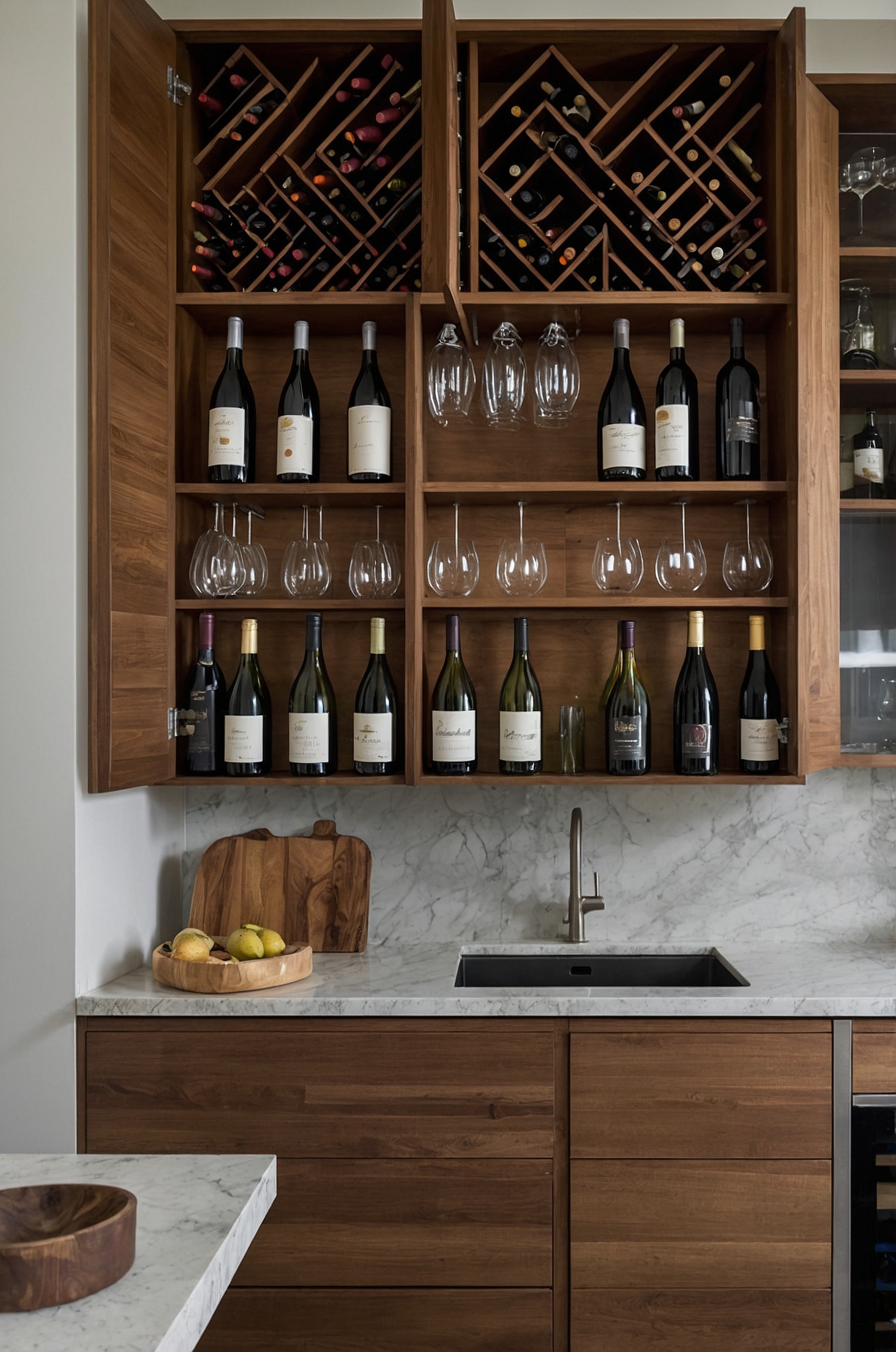I stood on my tiptoes, staring up at the awkward dusty void between my kitchen cabinets and ceiling, wondering why on earth builders create these strange spaces that seem designed purely to collect grease and cobwebs.
After moving into my new home last year, that forgotten zone had become my decorating nemesis – too high to reach easily, too visible to ignore, and way too boring just sitting there empty.
One Pinterest rabbit hole, three hardware store trips, and several creative weekends later, I’ve discovered that this neglected real estate can actually become one of the most character-defining spots in your entire kitchen.
That’s why I’m sharing these top seriously stylish ideas that transformed my kitchen from “meh” to “wow” – and will do the same for yours.
✨Click to Get My 101 FREE Designer Room Ideas
Create a Vintage Treasure Display


That awkward cabinet gap is absolutely perfect for showcasing those quirky vintage finds you’ve been collecting but have nowhere to display.
Think vintage soda crates, antique kitchen tools, retro appliances, or old-school advertising signs that add instant character.
The height creates natural separation from your everyday items while keeping special pieces visible and conversation-worthy.
Start by selecting a cohesive collection – either similar colors, materials, or themes work best to avoid a cluttered look.
Vintage breadboxes, old milk bottles, retro canisters, or antique cookbooks create an instant nostalgic vibe that adds layers of personality.
Consider adding small picture lights above certain pieces to create dramatic spotlighting effects in the evening.
Remember to dust these items regularly – their elevated position makes them dust magnets, but a quick weekly swipe keeps them looking intentional rather than forgotten.
Thrift stores, estate sales, and antique shops are goldmines for affordable statement pieces that tell a story.
Mix in one or two modern elements to keep the look fresh rather than stuffy or dated.
Position heavier items closer to the edges of cabinets rather than in the center for visual stability and safety.
For maximum impact, arrange items in varying heights, with taller objects positioned near the ends and shorter ones toward the middle for a pleasing visual rhythm.
The beauty of vintage collections is that they can be budget-friendly while looking incredibly curated and personal.
Install Dramatic Accent Lighting
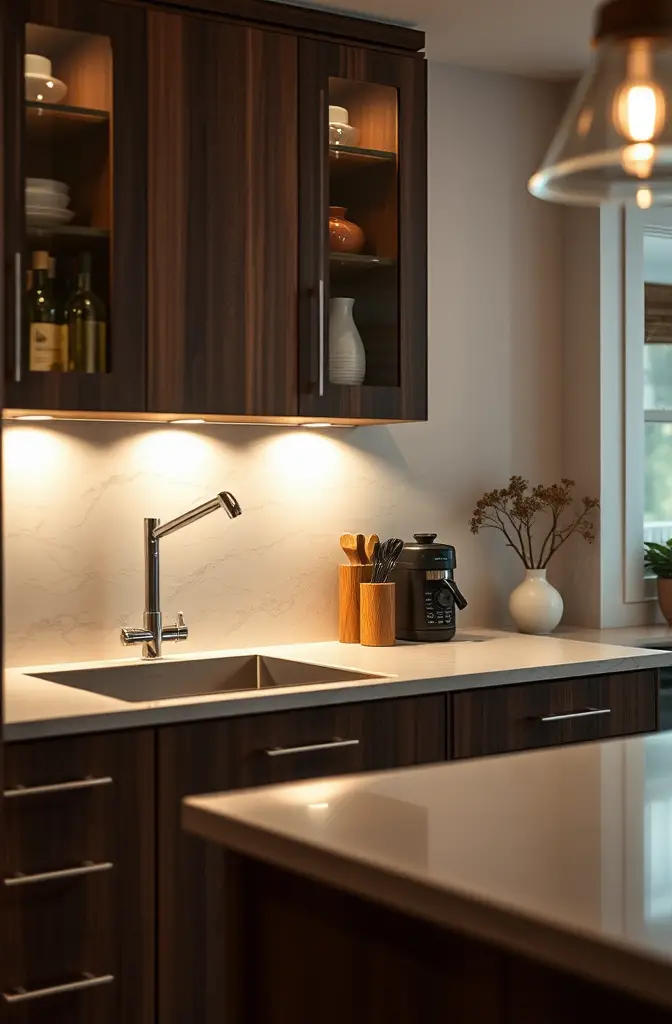
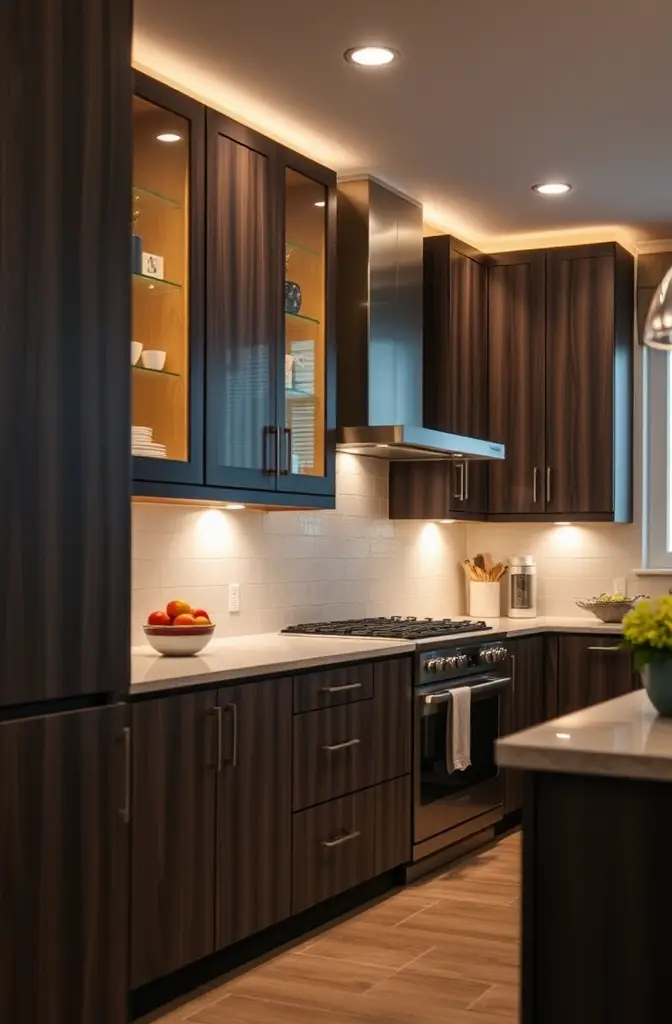
Transforming that shadowy space above your cabinets with strategic lighting might be the single most impactful change you can make to your kitchen’s entire vibe.
Installing LED strip lights along the top edges of your cabinets immediately adds a custom, high-end look that designers charge thousands to create.
The ambient glow creates an instantly cozy atmosphere, perfect for evening gatherings when harsh overhead lighting feels too intense.
Most LED systems now come with remote controls or smartphone apps that let you adjust colors and brightness levels to match your mood or occasion.
This lighting technique, called uplighting, bounces soft illumination off your ceiling, creating the illusion of higher ceilings and more spacious surroundings.
Warm white lighting (around 2700K-3000K) creates a welcoming, homey feel while cooler tones (4000K+) deliver a more contemporary, energizing atmosphere.
Installation is surprisingly DIY-friendly with peel-and-stick options requiring minimal technical skills beyond basic wiring connections.
For kitchens with textured or detailed ceilings, this lighting strategy highlights architectural features that might otherwise go unnoticed.
Consider adding a dimmer function to transition your kitchen from bright work space during meal prep to intimate dining nook as evening approaches.
Battery-operated options exist for renters or those not wanting to deal with electrical work, though they’ll need regular battery replacements.
The unexpected light source completely eliminates the “dust-collecting shelf” vibe, transforming a problem area into a deliberate design feature.
This lighting technique works equally well whether your above-cabinet space is 8 inches or 2 feet tall, making it versatile for various kitchen configurations.
Create a Mini Indoor Garden Oasis


Bringing living greenery to that high shelf space instantly transforms your kitchen from sterile to vibrant with minimal effort.
Trailing plants like pothos, ivy, or string of pearls create dramatic cascading effects that soften harsh cabinet lines and add movement to the space.
The elevated position keeps plants safely away from cooking splashes while giving them excellent access to indirect light – perfect for most houseplants.
Mixing different textures and heights creates visual interest – combine upright snake plants with sprawling spider plants and fluffy ferns.
Faux plants have come a long way in recent years, offering a maintenance-free alternative that still delivers the visual benefits of greenery.
Consider adding small grow lights on timers if your kitchen lacks natural light but you still crave real plants in the space.
Seasonal rotations keep the look fresh – swap in poinsettias and pine branches during holidays, bright flowering plants in spring, or dried wheat arrangements for fall.
Decorative pots and planters become part of the design story – copper containers add warmth, ceramic pots bring texture, while concrete planters offer modern industrial vibes.
The height naturally draws the eye upward, making your kitchen ceiling feel higher and your entire space more expansive.
Plants naturally improve air quality and add humidity to typically dry kitchen environments – functional decor at its finest.
Herbs like rosemary, thyme, or mint can thrive in this space with adequate light, adding both visual appeal and culinary convenience.
Remember to consider watering logistics – lightweight plastic nursery pots inside decorative containers make it easy to take plants down for watering without moving heavy pots.
Showcase an Artisanal Basket Collection
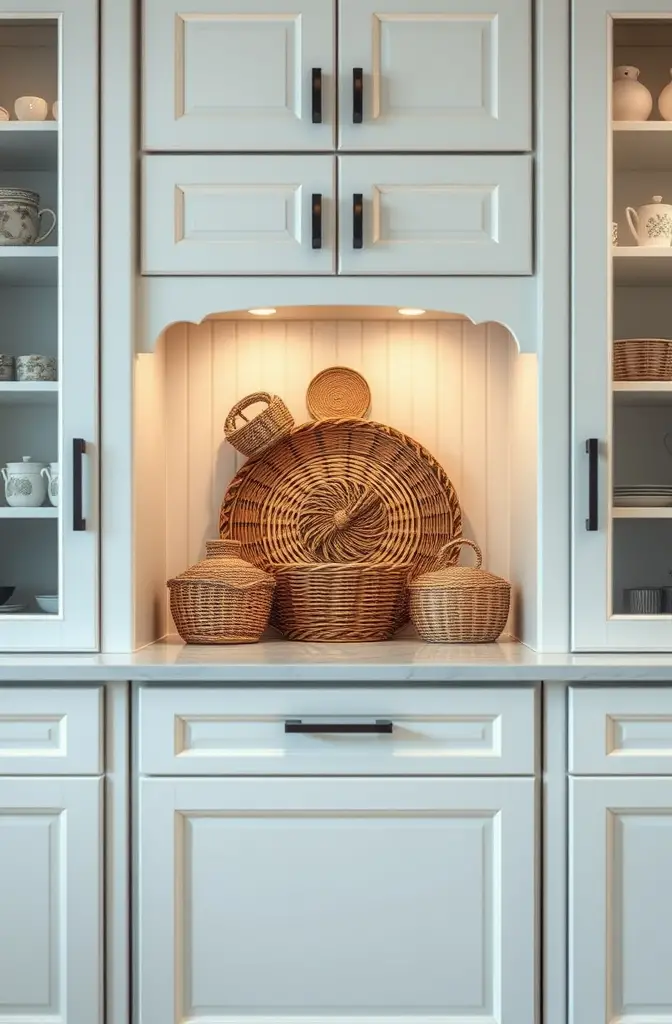
Woven baskets transform that awkward space into a textural wonderland while providing hidden storage for items you don’t use every day.
The natural materials bring warmth and organic elements to kitchens that might otherwise feel cold or too sleek with all their hard surfaces.
Varying basket sizes, weaves, and colors creates visual rhythm and prevents the display from looking too uniform or boring.
Global basket styles tell a story – incorporate African market baskets, Native American weaving, or Asian bamboo techniques for a well-traveled vibe.
Position baskets at slight angles rather than perfectly straight to create a more relaxed, collected-over-time appearance.
Shallow, wide baskets work particularly well in spaces with limited height between cabinets and ceilings.
Consider placing battery-operated puck lights inside larger baskets for a gorgeous evening glow that highlights the weaving patterns.
Baskets can double as practical storage for seasonal items, special occasion linens, or rarely-used serving pieces.
The textural contrast between smooth cabinet surfaces and woven materials adds immediate visual interest to your kitchen.
Vintage bread baskets, harvesting containers, or fishing baskets bring character that mass-produced options simply can’t match.
Mix in a few solid objects like ceramic pieces or wooden bowls among the baskets to create moments for the eye to rest.
Weather-resistant outdoor baskets can be brought inside for a more rustic look that holds up beautifully in kitchen environments.
✨Click to Get My 101 FREE Designer Room Ideas
Create a Cookbook Library Display


Transforming that dead space into a curated cookbook collection combines practicality with personalized style that reflects your culinary interests.
Colorful cookbook spines create an instant art installation that adds vibrant personality to neutral kitchens.
Arranging books by color creates a rainbow effect that’s both organized and visually striking from across the room.
Alternating vertical and horizontal stacking adds architectural interest while preventing the display from looking too rigid or library-like.
Cookbook collections tell your food story – from grandma’s handed-down recipe collections to modern celebrity chef tomes that showcase your culinary aspirations.
The height keeps precious vintage cookbooks safely away from cooking splashes while keeping them visible for inspiration.
Consider adding small bookends or decorative objects between groupings to create visual breaks and prevent toppling.
Leaving some breathing room rather than cramming the entire space with books creates a more curated, intentional look.
Paperback community cookbooks with their charming homemade aesthetic bring nostalgic warmth to modern kitchens.
Rotating seasonal or holiday-specific cookbooks to the front keeps your display dynamic and reflects the changing cooking calendar.
Beautiful coffee table-style cookbooks with gorgeous photography can be displayed face-out like artwork for maximum visual impact.
The weight of books makes them perfect for this space – heavy enough to stay put but accessible enough to grab when inspiration strikes.
Install Floating Shelves for Practical Elegance

Adding slim floating shelves transforms that awkward gap into functional storage that feels intentionally designed rather than an afterthought.
Unlike simply placing items on top of cabinets, shelves create a deliberate architectural element that looks like it was always meant to be there.
The clean lines of floating shelves without visible brackets maintain a sleek, modern aesthetic that works in virtually any kitchen style.
Staining or painting shelves to match your cabinets creates a seamless built-in look, while contrasting finishes make a bolder design statement.
This approach works particularly well in kitchens with varying cabinet heights, creating continuity across the entire wall.
Consider installing low-profile LED strip lighting underneath the shelves for dramatic illumination of displayed objects.
The depth of shelves can be customized to your space – deeper shelves accommodate larger items, while shallow ones prevent items from disappearing into shadowy recesses.
Wood shelving brings natural warmth to kitchens dominated by cool materials like stainless steel or marble.
The flat shelf surface eliminates the cleaning nightmare of dusty cabinet tops – a simple swipe and you’re done.
Display choices become even more important with shelving – curate collections of similar items grouped by color, material or function for a cohesive look.
For maximum impact, maintain consistent spacing between shelves to create a rhythmic visual pattern that’s pleasing to the eye.
The horizontal lines naturally draw the eye across the kitchen, making smaller spaces feel wider and more expansive.
Create a Seasonal Rotating Display
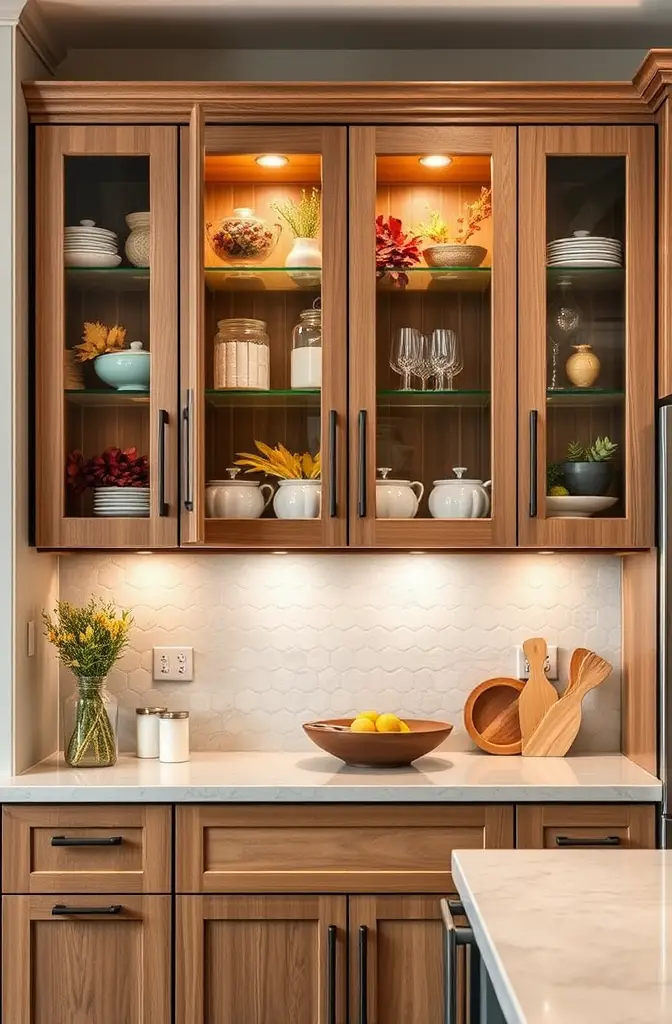
Dedicating your above-cabinet space to seasonal displays gives you permission to regularly refresh your kitchen’s look without major renovations.
The elevated position creates a perfect stage for holiday decorations that won’t interfere with your everyday cooking activities.
Seasonal switches prevent decorative fatigue – that feeling when you stop seeing your permanent decor because you’ve looked at it too long.
Spring arrangements might include pastel ceramics, flowering branches in tall vases, and bird’s nests for a fresh awakening feel.
Summer displays could feature coastal elements like blue glass bottles, rope accents, driftwood pieces, and shells collected from beach trips.
Fall naturally lends itself to warm copper containers, dried wheat arrangements, preserved leaves, and vintage wooden crates filled with mini pumpkins.
Winter holidays shine with evergreen garlands, twinkling lights, mercury glass, and collections of nutcrackers or vintage ornaments.
Color themes can remain consistent with your kitchen while textures and materials change to reflect the season.
Storage becomes simplified when you’re only displaying one season at a time – four labeled bins in your basement or garage keep everything organized.
The psychological boost of refreshing your space without spending much money creates a feeling of newness that’s deeply satisfying.
Children particularly respond to seasonal changes, creating memory-making rituals around helping to update the kitchen displays.
The height creates natural separation between everyday functional items and special decorative elements that might otherwise feel cluttered on countertops.
Display Statement Artwork for Unexpected Impact

Hanging artwork above your cabinets breaks all conventional rules in the most delightful way, creating a gallery-like atmosphere in an unexpected space.
The elevated position naturally draws the eye upward, making your kitchen ceiling feel higher while adding instant personality.
Unlike traditional kitchen backsplashes or refrigerator art, this placement keeps precious artwork safely away from cooking splatters and water damage.
Consider themes that complement kitchen activities – vintage food advertisements, produce crate labels, botanical prints, or abstract food photography.
Canvas prints work especially well in this space as they’re lightweight and don’t require glass that might create glare from overhead lighting.
The height requires scaling up – choose larger pieces or groupings rather than tiny artworks that will get lost in the space.
This approach works particularly well in open concept homes where your kitchen art becomes visible from dining and living areas.
Leaning artwork against the wall rather than hanging it creates a casual, collected vibe that’s easily changed without making nail holes.
Lighting strips installed along cabinet tops can highlight artwork like a professional gallery installation.
Black and white photography creates dramatic contrast in colorful kitchens, while vibrant abstract pieces add energy to neutral spaces.
Framing choices become part of the design story – chunky wooden frames add rustic warmth while sleek metal frames create contemporary polish.
This unexpected art placement signals confidence in your design choices – you’re breaking rules thoughtfully rather than simply following trends.
✨Click to Get My 101 FREE Designer Room Ideas
Create a Wine Bottle or Specialty Drink Display


That high space transforms into a sophisticated display zone for wine bottles, creating a European bistro atmosphere without dedicated wine storage.
Empty decorative liquor bottles with interesting shapes and labels become instant artwork when positioned strategically with subtle lighting.
The height keeps alcohol safely away from children while showcasing your cultivated taste to adult guests.
Consider arranging bottles by color for a stunning ombré effect that transforms everyday objects into deliberate design elements.
Vintage soda bottles, Italian mineral water containers, or artisanal olive oil vessels offer non-alcoholic alternatives with equally dramatic visual impact.
Position bottles at varying heights using hidden risers to create depth and prevent a flat, uniform appearance.
Small rope lighting woven between bottles creates a magical evening glow that highlights the glass colors and reflective surfaces.
This display works equally well with full bottles in active rotation or empty keepsakes from special occasions or travels.
The curved forms of bottles add a pleasing organic element that contrasts beautifully with the strict lines of kitchen cabinetry.
Amber and green glass bottles bring rich jewel tones to kitchens that might otherwise lack color and visual interest.
Consider grouping by region for a travel-inspired display that sparks conversation about favorite vineyard visits or dream destinations.
Oversized champagne bottles (magnums or larger) make particularly dramatic statements that become sculptural elements in the space.
Install Crown Molding with a Twist


Adding crown molding completely transforms that awkward gap into an intentional architectural feature that looks original to the home.
Unlike simply decorating the void, this approach actually modifies the space itself, creating a custom built-in appearance on a reasonable budget.
The vertical extension visually raises your cabinets to the ceiling, making standard-height cabinets look like premium custom installations.
Consider painting the molding in a contrasting color to your cabinets for a bold statement, or match exactly for a seamless extension.
Various molding profiles allow you to complement your home’s era – ornate detailing for traditional spaces or clean lines for modern kitchens.
The added trim creates a perfect ledge for discreet LED strip lighting that washes your ceiling with ambient illumination.
This approach eliminates the dreaded dust-collection zone while adding significant value to your kitchen’s overall appearance.
Combined with under-cabinet lighting, the crown molding creates a layered lighting effect that professional designers use in high-end homes.
Wood moldings bring warmth and traditional character, while painted MDF offers a budget-friendly alternative with identical visual impact.
For maximum impact, extend the molding treatment to adjacent built-ins or pantry cabinets for cohesive architectural continuity.
Consider adding simple recessed lighting above especially dark corners to eliminate shadows and showcase the new architectural detail.
The crisp edges draw the eye upward, making your kitchen ceiling appear higher and more dramatic than standard builder-grade installations.
Create a Vintage Background


Vintage signs transform that awkward space into a personal museum that tells your story through carefully curated typography and graphics.
The elevated position creates perfect sightlines for appreciating detailed lettering and artwork that might get lost at eye level.
Metal advertising signs bring industrial character that balances the often soft, organic nature of kitchen activities and materials.
Consider themes related to food, farming, or hospitality – old grocery signs, seed packets, fruit crate labels, or diner advertisements.
Leaning signs rather than hanging them creates casual depth and makes seasonal rotation simple without additional wall damage.
The varied sizes, shapes and materials of vintage signs create natural visual rhythm that breaks up the monotony of straight cabinet lines.
Black and white signs pop dramatically against colorful walls, while rusty, colorful signs add warmth to neutral kitchen palettes.
Authentic vintage pieces bring history and conversation starters, but reproduction signs offer budget-friendly alternatives with similar visual impact.
Grouping signs by theme, color, or era creates intentional collections rather than random accumulations of mismatched pieces.
The height naturally showcases larger statement pieces that would overwhelm other spaces in your home.
Neon signs or signs with subtle integrated lighting create magical evening ambiance when overhead lights are dimmed.
This approach works particularly well in farmhouse, industrial, or eclectic kitchen styles where patina and character are celebrated design elements.
Create Architectural Interest with Corbels and Brackets

Decorative corbels and brackets transform that plain space into a custom architectural feature that looks original to the home.
The ornate details add instant character to builder-grade cabinets, elevating their appearance to custom-designed quality.
Spacing corbels at regular intervals creates a rhythmic pattern that draws the eye along the entire kitchen for a cohesive look.
Painted to match your cabinets, they create seamless integration, while contrasting finishes make bold design statements.
Wood corbels bring warmth and craftsmanship to modern kitchens that might otherwise feel cold or too sleek.
Consider placing small objects, trailing plants or battery-operated candles between corbels to enhance the dimensional effect.
This approach works particularly well in traditional, Mediterranean, or Victorian-inspired kitchens where architectural detailing is expected.
The shadows cast by dimensional corbels add visual texture that flat decorative elements simply cannot achieve.
Repurposed architectural salvage pieces bring authentic history and character that new reproductions can’t quite match.
For a cohesive look, select corbel styles that complement other woodwork in your home like stair balusters or fireplace mantels.
The verticality naturally draws the eye upward, making your kitchen ceiling feel higher and more dramatic.
Unlike purely decorative solutions, this architectural addition actually becomes part of your kitchen’s structural language.
✨Click to Get My 101 FREE Designer Room Ideas
Create a Dramatic Plate and Platter Display

Displaying decorative plates and platters transforms utilitarian storage into a personalized gallery that showcases your collection and taste.
The elevated position prevents damage to special pieces while keeping them visible for enjoyment rather than hidden in cabinets.
Layering plates at different angles on plate stands creates dimensional interest that flat-against-the-wall arrangements lack.
Themed collections – blue and white china, hand-painted ceramics, or commemorative plates – tell visual stories about your interests and travels.
The circular shapes provide pleasing contrast to the predominantly straight lines and right angles found in most kitchens.
Consider arranging by color for dramatic visual impact – gradients from light to dark or complementary color groupings.
Intersperse plates with other objects like small framed artwork, plants, or decorative boxes to prevent a one-dimensional display.
Varying the heights and depths of items creates natural layers that add sophisticated dimension to the arrangement.
Family heirloom pieces find perfect placement here – visible for enjoyment but protected from the daily hazards of kitchen activities.
The reflective surfaces of ceramic, porcelain and glass catch and amplify light, adding brightness to often shadowy areas.
This approach works equally well with inexpensive thrift store finds as it does with valuable collectibles – it’s the curation that matters.
For maximum impact, consider adding small puck lights strategically positioned to highlight special pieces in evening hours.

